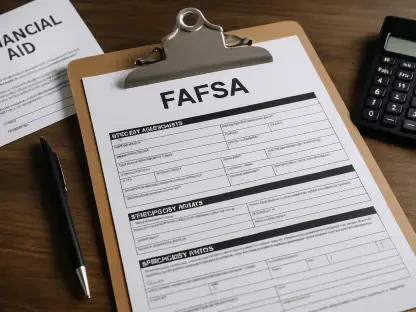Michigan’s K-12 education system is facing a paradoxical situation. While student enrollment numbers are declining, state education revenues are on the rise. This unique scenario presents both challenges and opportunities for policymakers, educators, and communities to rethink and revitalize the state’s education framework. At the heart of this complex issue lies the need to address funding dynamics, structural considerations, and the role of charter schools. By doing so, Michigan can create a more equitable and efficient education system that meets the diverse needs of its students.
Shrinking Enrollment and Funding Dynamics
Michigan is experiencing a significant decline in K-12 student enrollment. This trend poses a challenge for schools that rely on per-student funding to maintain operations and quality education. However, in a somewhat contradictory turn of events, the state’s education revenues are expected to increase. This provides a unique opportunity to restructure the K-12 funding formula effectively. Experts like David Arsen from Michigan State University and State Superintendent Michael Rice strongly advocate for the revision of the funding formula by increasing the minimum foundation grant per student. This approach aims to ensure that schools have the necessary resources to support all students, particularly those from marginalized communities.
By adjusting the funding formula to allocate more resources to at-risk students, English-language learners, and children with disabilities, Michigan can create a more equitable education system. Historically, recent increases in Michigan’s education funding have been channeled through categorical funding rather than boosting the foundational grant. This shift has faced criticism for creating complexity and administrative burden. Simplifying the funding system by increasing the foundational grant and granting more autonomy to individual districts can help address these challenges more efficiently. A simplified funding system would allow districts the flexibility to allocate resources tailored to their unique challenges while reducing bureaucratic red tape.
Funding Formula Reform
The need to revamp Michigan’s K-12 funding formula is a common theme among experts and stakeholders. Increasing the minimum foundation grant per student and adjusting the formula to allocate more resources to disadvantaged students are key recommendations. The 2018 consultant recommendations suggest increasing the base foundation grant substantially, from $9,608 per student currently to $12,175 per student in 2025 dollars adjusted for inflation. This proposed increase would be accompanied by significant multipliers for students from low-income backgrounds, English-language learners, and children with disabilities.
This approach aims to create well-resourced schools that can serve as community revitalization hubs, potentially reversing population declines by retaining and attracting families. Simplifying the funding landscape by reducing the reliance on categorical funding is also crucial. While categorical funding does address specific needs, it complicates the funding process with numerous earmarked grants, each requiring detailed applications and compliance. A simplified system, which increases the foundational grant and allows districts the flexibility to allocate resources as per their specific challenges, is favored by many experts and policymakers. This approach ensures that the resources are deployed effectively where they are needed the most, providing districts the autonomy to innovate and address their unique problems.
Structural Considerations and Economies of Scale
Michigan’s large number of school districts raises questions about the efficiency and sustainability of its educational infrastructure. With only 117 districts exceeding 2,900 students and almost 500 having fewer than 1,000, the debate on consolidation versus maintaining district identity persists. Political and community identity concerns make outright consolidation challenging. Instead, “soft consolidation” through inter-district collaborations and reliance on intermediate school districts (ISDs) for shared services is seen as a pragmatic approach. This form of collaboration can achieve economies of scale without undermining community identity or local governance.
Leveraging ISDs and fostering inter-district collaborations for back-office and operational support can deliver operational efficiencies. This approach allows districts to maintain their unique identities while benefiting from shared resources and services. It ultimately leads to a more efficient and sustainable education system. By pooling resources and expertise, districts can improve the quality of education while optimizing costs. For instance, shared services could include joint transportation, special education programs, and administrative operations.
Charter Schools’ Role and Impact
Charter schools constitute a third of Michigan school districts and account for 11% of public school enrollment. While they offer choice and fill educational voids, they also contribute to financial destabilization in traditional districts due to accelerated enrollment declines. The introduction and expansion of charter schools have provided educational choices but have also strained traditional public schools. Proposals for tightening charter regulations and possibly limiting the establishment of new charters in oversaturated areas are part of the ongoing debate.
Managing the growth of charter schools effectively is crucial to ensuring they complement rather than disrupt the educational ecosystem. Policy reforms aimed at balancing the dynamics between charter schools and traditional public schools can help create a more stable and cohesive education system. Charter schools were initially introduced as innovation hubs and parental choice alternatives in the 1990s. However, their rapid expansion has created significant challenges for traditional public schools, particularly in urban areas with already strained educational ecosystems.
Balancing Charter School Dynamics
To address these concerns, policymakers are now considering reforms to manage the growth of charter schools effectively, ensuring they complement rather than disrupt the educational ecosystem. By implementing policy reforms that balance the dynamics between charter schools and traditional public schools, Michigan can create a more stable and cohesive education system. This approach aims to ensure that all students have access to quality education, regardless of the type of school they attend.
Ensuring that charter schools operate under stricter regulations could mitigate the financial destabilization of traditional districts. Moreover, by focusing on improving traditional schools’ infrastructures and pedagogical methodologies, the competition fostered by charter schools could potentially drive overall educational standards higher. Through thoughtful and balanced policy reforms, the state can ensure that all educational institutions work harmoniously towards providing every child with the educational opportunities they deserve.
Conclusion
Michigan’s K-12 education system finds itself in a complex and seemingly contradictory situation. On one hand, student enrollment numbers are steadily decreasing. On the other hand, state education revenues are experiencing an upswing. This unusual combination presents both significant challenges and potential opportunities for policymakers, educators, and communities to rethink and overhaul the state’s educational framework.
One of the primary tasks at hand is to address the funding dynamics that underpin the educational system. With fewer students, resource allocation becomes a critical issue, as funds must be managed efficiently to support all schools and programs. Structural considerations also need to be examined to ensure that resources are deployed where they are most needed.
Additionally, the role of charter schools cannot be overlooked. These institutions often operate with different funding models and educational approaches than traditional public schools, and finding a balance that serves all students equitably is essential. By addressing these key areas—funding, structure, and the role of charter schools—Michigan has the opportunity to create a more equitable and efficient education system. Such a system would be better equipped to meet the diverse needs of its students, paving the way for a brighter educational future.









